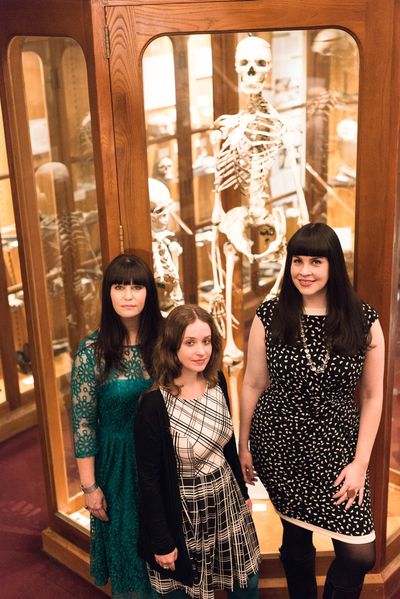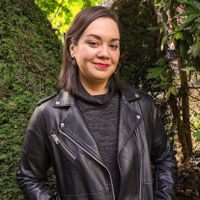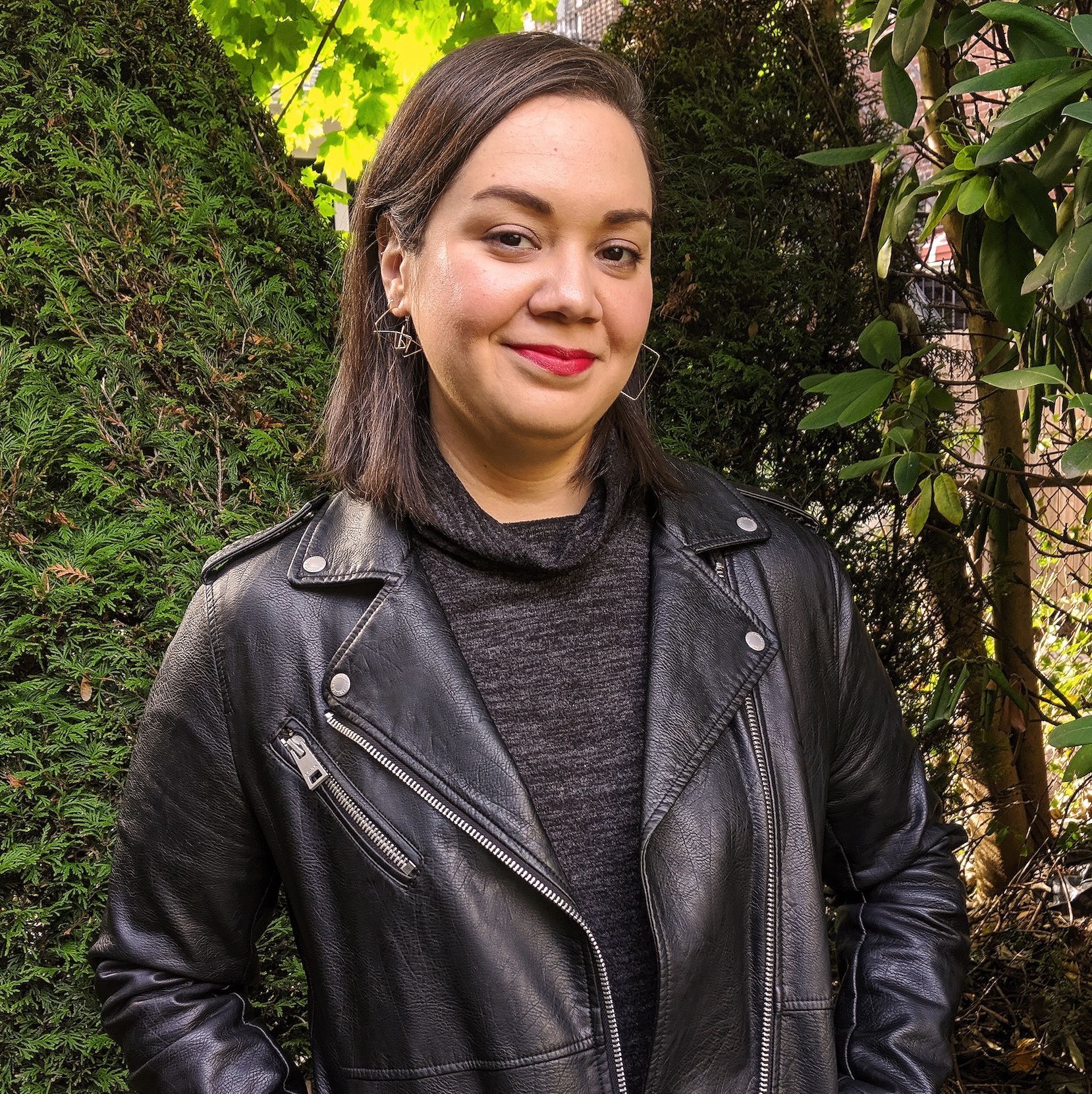The Women Who Love Death
Young women are more paranoid about their own demise than ever before. Enter "death positivity," a new female-driven trend aimed at turning that fear on its head.
About a dozen people are gathered at the Morbid Anatomy Museum in Brooklyn, New York for its monthly death café, an event designed to prompt discussions about, as you may have guessed, death. We're sitting in the library at a dark wood table topped with two emerald green banker's lamps. What I see when I look around: specimen jars, wax figurines, anatomy prints, preserved butterflies, books, religious artwork, and a set of human teeth displayed in a black case like a pair of earrings at Claire's. For two hours, we chat about our own experiences with death, learn about alternative funerals and "green" burials, and nod at phrases like "closure is a myth" and "to talk about death is to appreciate life" while eating shortbread cookies.
That's the thing about "death positivity"—it's not about wanting to die. It's about feeling better about death in order to feel better about living.
"It's refreshing," Gianina Galatro, a 26-year-old media planner, says of attending her fourth death café today. "Bring up death in a random room, and it's like, 'Wow, way to bring down the mood.' But whenever I leave a death café, I feel so happy."

The leading women in death: Sarah Troop (left), Megan Rosenbloom (middle), Caitlin Doughty (right)
That's the thing about "death positivity"—it's not about wanting to die, looking forward to dying, or fantasizing when and where and how it'll happen. It's about feeling better about death in order to feel better about living. It's about, in a way, alleviating the I'm-sure-something-horrible-is-going-to-happen-to-me paranoia that grips so many young women these days.
In fact, the "death positivity" movement is being led by women—female morticians, writers, academics, and artists—as an answer. Their cause has evolved over the last few years from online communities to annual events to, now, an entire museum.
Caitlin Doughty, 32, was there at the beginning. In fact, she's pretty much the mother of the whole thing. (The New York Times bestselling author of Smoke Gets in Your Eyes: And Other Lessons from the Crematory, she's credited with coining the term "death positivity" and for spurring the phenomenon of more open conversations about dying with her popular YouTube series Ask a Mortician.) "It's not, 'Oh, your dad died? Just be positive about it. It's okay!'" she explains of the movement's goal. "It's realizing the fact that we're all going to die is our greatest cultural force. It affects our desire to achieve, have children, get married. It affects everything we do."
Not that Millennials need reminding that death looms large around every possible corner.
Maybe it's all the apps and fitness trackers that tell us exactly how alive we are at any given moment. Or the constant stream of new studies revealing that everything we love will give us cancer. Or the collective mourning on social media that immediately follows a celebrity death. Or the incessant mass shootings and Reddit threads that follow them. Or the chilling headlines about young women being raped and murdered while out on a jog, while leaving the office, while on vacation.
Get exclusive access to fashion and beauty trends, hot-off-the-press celebrity news, and more.

Tonya Hurley, author and founding board member of the Morbid Anatomy Museum, makes her way through the crowd at an after-party for a fundraising gala
For all these reasons and then some, young women are experiencing death anxiety more than ever. In data pulled for Marie Claire by OkCupid.com earlier this spring, only 28 percent of male users answered yes to the question: "Have you created a 'Things To Do Before I Die' list?" That's nearly half the percentage of female users who answered the question the same way (52.6 percent). Part of it, perhaps, is timing. According to a study published in 2007 by a group of University of North Florida, Jacksonville researchers, death anxiety peaks for men and women in their 20s, but for women, there's a "secondary spike" during their 50s, which men don't experience.

DJ Andi Harriman spinning at the Morbid Anatomy Museum\'s fundraising gala after-party
There's also this: Today we don't engage with death in the way we might if we time-traveled back to a period before vaccines and the marvels of modern medicine. Before you could pick up protein at Whole Foods without raising and slaughtering it yourself. Before you visited dying loved ones at a sterile hospital rather than tending to them at home.
Without a regular face-to-face relationship with death, we've developed an aversion to the subject entirely.
But, it turns out, death can be sort of fun.
At the after-party for the Morbid Anatomy Museum's annual fundraising gala this past April, guests—older artistic types who look like cooler versions of your parents, and hipster-y 20-to-30 somethings with beards and bangs and lots of black—chatted with each other between trips to the bar about near-death experiences and how they'd like to die. There were tarot card readings. An insect petting zoo. And even a palm reader, who held her iPhone over my two palms in the dimly lit space to tell me I'll find true love later in life, not when I'm old-old but when I'm middle aged. Bad news for my boyfriend, who pays for the reading when I learn she's cash-only. The good news, though, is that I'll avoid certain death for at least another two decades. "It's the funnest place I've ever been," says Tonya Hurley, 45, New York Times bestselling author behind the ghostgirl fiction series and founding board member of the museum, "being surrounded by all this death!"
For the rest of us who may not have warmed up to the topic quite yet, part of our uneasiness, says Bri Barton, a 27-year-old artist in Philadelphia, is based on certain societal values. "Our culture is youth- and growth-focused," she says. "Anything that reminds of us of decay or mortality terrifies us." Last November, Barton self-published an all-ages coloring book titled Everything Dies! A Coloring Book About Life!, the first 1,000 printing of which sold out in four months. The project began as a way of coping with a "string of sudden deaths" when Barton lost six loved ones in an eight-month period. "All of these people are dying around me and all I wanted to do was talk about it," she says. "But every time I mentioned 'this person died,' everyone froze and no one knew what to say next. And it was just like, dude, there's one thing that happens to all of us. We have to be able to talk about it."
People do talk about it in small (but growing) circles of similar-minded people. Take Death Salon, the discussions, panels, performances, even parties that make up the events arm of Doughty's non-profit Order of the Good Death. The group's first-ever event took place in October 2013 at L.A. rock venue Bootleg Theater—and the turnout shocked organizers. "No one knew our name, and we didn't do a ton of promotion, but when we showed up it was sold out," says Megan Rosenbloom, 34, co-founder and director of Death Salon and a medical librarian at the University of Southern California. "We didn't have any seats because it's a rock club, but people sat on the floor because they wanted to watch everything to the end. We were like, Wow, okay, something is happening here." There have been five events since (in London, San Francisco, Philadelphia, Houston, and another in L.A., at the Getty Villa).
without a regular face-to-face relationship with death, we've developed an aversion to the subject entirely.
Rosenbloom thinks about death every day—which, to her, is a good thing. "There are a lot of studies that say people who think about death more are actually happier because humans are wired to value things that are perceived as finite," she says. And she's gained a sense of preparedness for the inevitable losses to come. Earlier this year, her experience at Death Salons helped Rosenbloom cope with an unexpected death in her family, from making funeral arrangements (pro tip: you don't need to embalm a body before it's cremated, something funeral directors often fail to explain before charging you for the unnecessary expense) to what not to say to grieving family members ("she's in a better place" and "everything happens for a reason" = particular pain points). Sometimes you have to get comfortable with the idea of a crisis before it's staring you in the face.

The Morbid Anatomy Museum in Brooklyn, N.Y.
Like on a recent Saturday afternoon inside the basement of the Morbid Anatomy Museum, where everyone—11 women and one man seemingly plucked from the pages of an Urban Outfitters catalog—is hunched over their plates in concentration. Somewhere else, this could be brunch. But there are no mimosas here. Just tiny dead white mice being skinned.
Divya Anantharaman, 32, stands in the center of the room encouraging the attendees to dive in, her purple ombre hued hair in a messy bun. For the former Pratt Institute design student, taxidermy was a hobby until three years ago when she quit her freelance fashion work and turned the practice into her full-time job; now she teaches an increasingly popular sustainably-sourced taxidermy workshop in Brooklyn.
"It's the funnest place I've ever been, being surrounded by all this death!"
Fellow taxidermist Katie Innamorato, 26, who has the long wavy brunette locks and casual pitch-black style of an off-duty metal-band frontwoman, theorizes about the surging interest in their artform: "It's another way for people to relate back to nature and to death." Both women teach regularly sold-out classes, which cost between $100 and $450, in cities like L.A., Portland, Detroit, and Atlanta, with women, mostly in the 20s through 40s, making up the majority of their students. This month, Anantharaman and Innamorato released a part how-to, part history book on the subject, Stuffed Animals.

Katrina Spade, founder and executive director of the Urban Death Project in Seattle
The fact that women are both driving and consuming the death positivity trend is not exactly coincidental. The women in death movement is actually a resurgence. "Typically death care [tending to the dying, making arrangements for funerals and wakes, preparing the body for burial] was considered feminine work," says Sarah Troop, 41, curator at the Lindsey Museum Gallery in central California and executive director of the Order of the Good Death. "That was taken out of our hands and professionalized by men who said, 'This is not something you can do, there's science here, it's a business, this is not a place for you.'"
Not today, and not anymore. Just look at mortuary science schools, Troop says, where classes are now "overwhelmingly comprised of female students." (More than 60 percent of mortuary school students are female, according to National Funeral Directors Association.) Or outside the classroom where entrepreneurial women like Katrina Spade, the founder and executive director of the Urban Death Project in Seattle, W.A., are finding ways to decompose dead bodies at a faster-than-normal pace to turn them into soil for use in green spaces.
Ask any woman in the movement and she'll tell you that constantly thinking about death is one of the best things that ever happened to her. Being reminded that we're "mortal creatures," as Doughty puts it, forces a sort of clarity about not sweating the small stuff. "It makes you focus on and appreciate the moments you have," Spade says.
A sense of humor helps, too. "I've always been a little afraid of dying," Spade admits, "but now when I get on a plane, I'm like, I can't die. I'm going to a meeting about the Urban Death Project. It'd be too ironic."

As deputy editor, Jen oversees Cosmopolitan's daily digital editorial operations, editing and writing features, essays, news, and other content, in addition to editing the magazine's cover stories, astrology pages, and more. Previously, Jen was a senior editor at Marie Claire. Before that, she worked at GQ.

